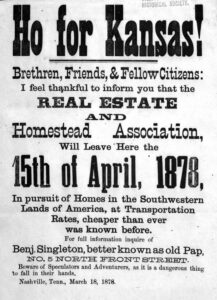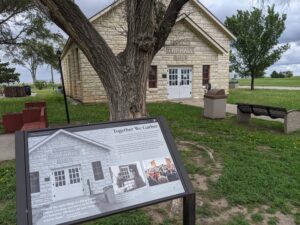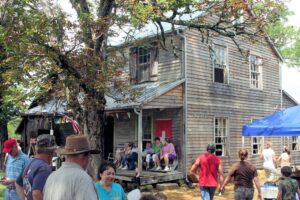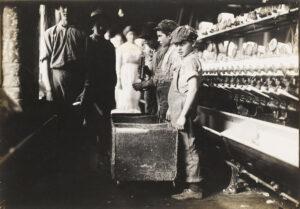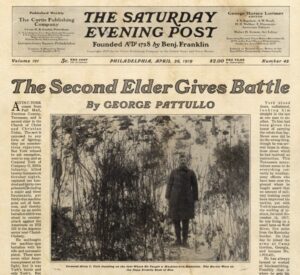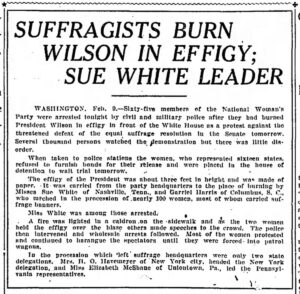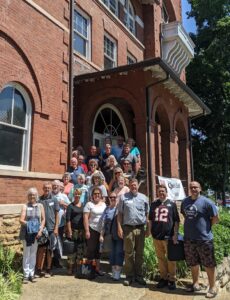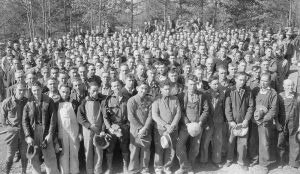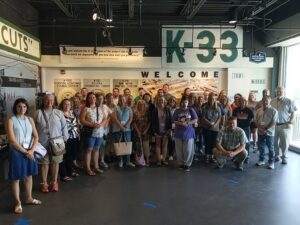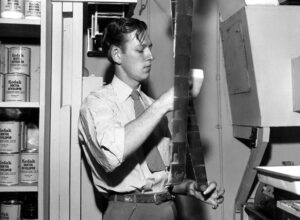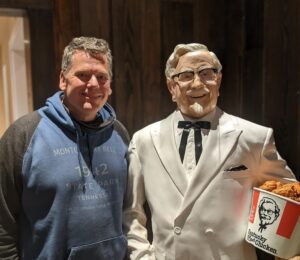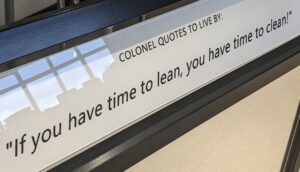Teacher’s Guide to Don’t Keep Them in Doubt (2027 Edition)
Welcome to the teacher’s guide to the 2027 edition of the 11th grade Tennessee History for Kids booklet called Don’t Keep Them In Doubt.
Since the standards for the US history class aren’t changing very much, this booklet can be used regardless of whether you are teaching the 2019 or 2027 standards. The only major topic that is moving away from the U.S. history class is the Coal Creek saga, which is moving to the fifth grade Tennessee history semester. Click here if you teach the high school history class and need material that covers Coal Creek.
If you would like the answers to the quiz questions in the booklet, please email me at bill@tnhistoryforkids.org and tell me your name and the school at which you teach.
Chapter 1: Slavery to the Exodusters
Nicodemus National Historic Site in Kansas is devoted to the story of the Exodusters. We drove up there and did this virtual tour of the place.
The circular on page 4 is shown on the left. Click on the image to see a larger version of it.
A part of Topeka, Kansas, is called Tennessee Town because it was originally settled by Exodusters from Tennessee. Click here to learn more about this.
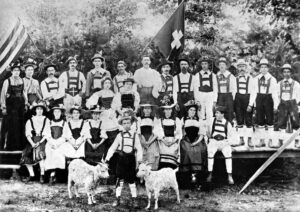 Chapter 2: Foreign Colonies
Chapter 2: Foreign Colonies
The photo on page 8 may be the best photo in the entire booklet (especially the goats in the front). Click on the image on the right to see it bigger (and it is courtesy of the TN State Library and Archives.)
Since we printed this booklet in black and white, and since the photo on page 11 is in color, we thought we show you that as well, on the left.
Click here to be taken to the website of the Grundy County Swiss Historical Society.
Chapter 3: Children in Cotton Mills
You won’t have trouble finding out more about Lewis Wickes Hine; click here for a website about him that is associated with the International Center of Photography.
In spite of Hine’s remarkable contribution to American history and to the welfare of children, he was not honored in his lifetime, and he died poor. I also find it very interesting that, after his death, the Museum of Modern Art did not accept his photo collection, but the George Eastman Museum did.
If you start digging on the history of some of the people and buildings which appear in some of Lewis Hines’ photographs, you really can find some very interesting stuff. For instance, the photograph on page 15 shows some young boys working in the Elk Cotton Mills. The Elk Cotton Mills building is still standing. Click here to read more about it.
Chapter 4: Old Hickory Division
Thanks to the Tennessee State Library and Archives TEVA website, you can see the famous article that made Alvin York famous. Click here to see it.
The story about Kaiser Wilhelm’s ashtray has made its way into many national articles. Click here for a story on CBS Sportsline about it.
In addition to the content in this chapter, I once wrote a column about World War I’s impact on Tennessee. Click here to read it.
Chapter 5: Ladies and “Half Crazed Fanatics”
Click on the images on the right and the left to read two of the newspaper articles referred to in this chapter.
I can’t say enough good things about Elaine Weiss’ book The Woman’s Hour. If you have any interest whatsoever about this topic, I highly recommend that you read it.
Finally, I need to point out that there are differences of opinion about exactly who is shown in the photograph on page 29. The folks at the Belmont-Paul Woman’s Equality National Monument weren’t 100 percent sure about the identity of the man shown on the far left, nor am I. However, I’m inclined to think it is Banks Turner of Gibson County.
Chapter 6: Trumpet and Fiddle
Turn up the speakers and clear a space in the classroom for students to move their feet if they like! Here are some links to some of the music referred to in this chapter:
* W.C. Handy “Memphis Blues”
* W.C. Handy, “St. Louis Blues”
* Humphrey Bate and his Possum Hunters, “How Many Biscuits Can You Eat?”
* Uncle Jimmy Thompson, “Lynchburg”
* DeFord Bailey, “Davidson County Blues”
Chapter 7: Cross of 300 Light Bulbs
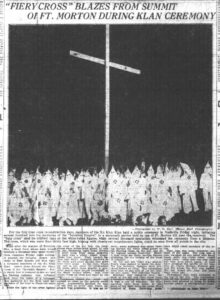 I wince whenever I see textbooks talk about the “Progressive Era” without mentioning the era’s racial side. That, and the many newspaper articles and ads I’ve found over the years, is why I produced chapter 7.
I wince whenever I see textbooks talk about the “Progressive Era” without mentioning the era’s racial side. That, and the many newspaper articles and ads I’ve found over the years, is why I produced chapter 7.
IF YOU THINK YOUR STUDENTS ARE MATURE ENOUGH TO DEAL WITH THIS, click on the right to see a front-page story and photo that appeared in the Nashville Banner on June 2, 1923. Photos didn’t accompany local news stories very much in the 1920s, but obviously it did on this occasion. The hill where this KKK meeting occurred now has Carter Lawrence Elementary School and the Belmont University baseball stadium on it.
On page 34, I try to explain the state’s use of “a large” voting districts to dilute the African-American vote. Please let me know (I can be reached at bill@tnhistoryforkids.org) if you can come up with a better way to explain this.
Click here for a virtual tour “In Search of Ida B. Wells.”
Chapter 8: Trial of the Century
The photo on page 39, which also appears on the cover of this booklet, has never been published in print prior to the publication of this booklet. Here’s the story behind it:
The Chicago Tribune sent a photographer to Tennessee to take photos for the Scopes Trial. That photographer took and developed many photographs, but only a small number of them were actually printed in the Tribune during the weeks in which the Scopes Trial remained in the news. The one shown here (and also pages 41 and 42) are three of the many Scopes Trial photos which had been in the morgue of the Tribune for 90 years!
Click here to see A Civic Biology, the textbook at the center of the 1925 controversy.
I can’t say enough about the Scopes Festival, which the city of Dayton and the folks at Bryan College put on every year. Click here to check it out, and I strongly recommend going to see the drama that they put on.
Click here to see a video that Tennessee History for Kids put together about the Scopes Trial.
Chapter 9: Taming the River
More information about this topic on the Tennessee History for Kids website and my columns:
* Click here for a virtual tour of the Butler Museum in Johnson County.
* Click here for a virtual tour of Norris Dam and the area around it.
* Here for the Marion County history page.
* Here for a column about hydroelectric dams built on the Tennessee River system about a generation before TVA.
Finally, I figure that about half of Anderson County has an ancestor who appear in the photograph on page 47. Click on it (to the right) to make it larger.
Chapter 10: Planes, Maneuvers and POW Camps
Click here to see more of the photos in the MTSU “Tennesseans in World War II” collection.
Click here for a column I wrote about Tennessee’s World War II Medal of Honor recipients.
.
Click here to read a column I once wrote about Gerhard Hennes and Camp Crossville. I’ve been doing this column for 19 years, and this one has had more reaction, by far, than any other column I’ve ever written.
Finally, an Army Master Sergent from Knoxville named Roddie Edmonds was recently nominated for the Congressional Gold Medal for something he did in an German prisoner of war camp during World War II. Click here to read about this remarkable man’s deeds.
Click here to be taken to the website of the Smith County Historical Tourism Society, which puts on an annual World War II living history event. If you can figure out of a way for your students to go to this May event, they will love it!
Chapter 11: Secret City
Click here for a website associated with the USS Indianapolis survivors organization and here for the U.S. Naval Institute online archives of Alfred Sedivi’s photo collection.
Click here for a virtual tour of the historical exhibits at the Museum of Science and Energy at Oak Ridge. I’d like to thank Oak Ridge historian Ray Smith for his help in putting this material together. Ray frequently speaks at our inservices (in-person and virtual). Stay tuned for more of this wonderful appearances!
Almost all of the photographs taken at Oak Ridge during the Manhattan Project era were taken by one man–photographer Ed Westcott. Click here to see some of his photos.
Mr. Westcott died on March 29, 2019. Click here for his obituary.
Chapter 12: Superhighways
Click here for a column I wrote about Citizens to Preserve Overton Park v. Volpe.
Click here to see parts of the important U.S. government document known as the “Yellow Book,” which would eventually determine where interstate corridors would go through Tennessee’s four major cities.
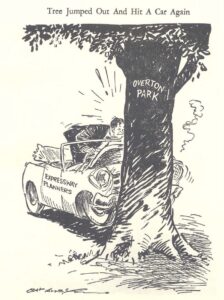 Click on the image on the right to show your students the editorial cartoon on page 67. (Obviously, students today need to know what editorial cartoons are, and they don’t have a chance to see them as much as people did in previous decades.)
Click on the image on the right to show your students the editorial cartoon on page 67. (Obviously, students today need to know what editorial cartoons are, and they don’t have a chance to see them as much as people did in previous decades.)
Holiday Inn and the Colonel
I recommend a trip to the Sanders Cafe and Museum in Corbin, Kentucky. (While there, go see Cumberland Falls — the waterfall so awesome that it forces the Cumberland River downstream to Nashville!) As you can see on the left, I visited Corbin and said hi to the Colonel.
I’m afraid I know a lot about Colonel Sanders, Jack Massey and Kentucky Fried Chicken, because I wrote two full-length books about the subject: Fortunes Fiddles and Fried Chicken: A Nashville Business History and Master of the Big Board: The Life Times and Businesses of Jack C. Massey.
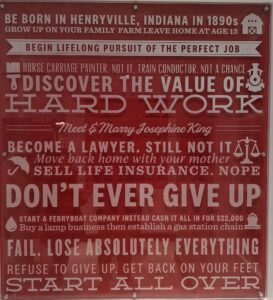 However, I have to admit that I learned a lot about the Colonel at his museum. In truth, Sanders had ever reason to believe that he was a failure. The museum explains how many jobs he went through before he started his fried chicken chain — ferry operator, train conductor, life insurance salesman, lawyer, and so on.
However, I have to admit that I learned a lot about the Colonel at his museum. In truth, Sanders had ever reason to believe that he was a failure. The museum explains how many jobs he went through before he started his fried chicken chain — ferry operator, train conductor, life insurance salesman, lawyer, and so on.
My favorite display there was the quote on the right. “If you’ve got time to lean, you’ve got time to clean.”
Chapter 13: Money from Music
Click here to taken to the website of the Sun Studio in Memphis and here to be taken to the website of the Stax Museum.
 Ready to hear some young girls scream? Click here to see Elvis Presley performing the song “Hound Dog” on the Ed Sullivan show in 1956, and click here to read more about that appearance.
Ready to hear some young girls scream? Click here to see Elvis Presley performing the song “Hound Dog” on the Ed Sullivan show in 1956, and click here to read more about that appearance.
Ready to laugh? Click here to see B.B. King explain how he got his first big break, writing an advertising jingle for an over the counter medicine called Pepticon.
By the way, the Castle Recording Studio that operated in downtown Nashville in the late 1940s has nothing to do with another business that operates in Williamson County under that same name today.
Chapter 14: Highlander
Click on the image to the right to read the beginning of one of the articles about the Highlander Folk School that was published by the Nashville Tennessean in 1939.
Click on the left to see a larger version of the image at the top of page 79.
Click here to be taken on a Tennessee History for Kids virtual tour “In Search of Highlander.”
This developing story: In April 2019, one of the buildings at the Highlander Education and Research Center burned in an apparent arson. A white power symbol was found on the site, raising the possibility that the fire was set by a terrorist organization. Click here to see a story about this.
Chapter 15: Tent City
The best way to learn more about the Tent City Movement is from the folks at the Benjamin Hooks Institute for Social Change. Click here to explore its website.
Most of the photos that exist of the Tent City Movement, and many of the photos of the Civil Rights Movement in Memphis and Northern Mississippi, were taken by Ernest C. Withers. Today there is a gallery of Withers’ photographs on Beale Street, and you can click here to see the organization’s website.
Chapter 16: Custom of the People
Here, on the right, is a photograph that was taken of Bobby Cain after I interviewed him on stage at the Tennessee History Tent Revival event in July 2017.
Click here for a public radio story about that event in which Cain was interviewed.
Sit Ins
Click here for a remarkable 1960 documentary associated with the Nashville Sit-Ins which includes short interviews of some of the students, police officers, and attorneys who took part in the event.
Rather than buying a single classroom set, please consider buying one for every student. We sell these booklets for only $2.50 and print them on non-glossy paper because we want students to write in their booklets and treasure them. We believe students are more likely to value something when they are allowed to keep it.
Please do NOT copy the booklets. That is a violation of our copyright and makes it difficult for us to continue to exist. The reason we sell them for only $2 is so teachers will not be tempted to copy the booklets.
